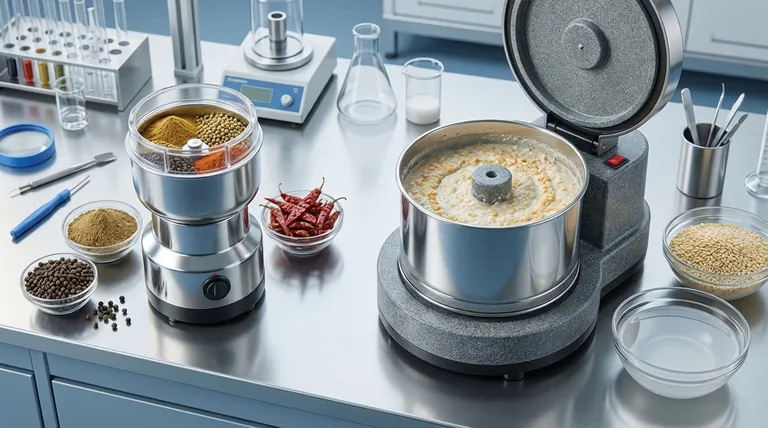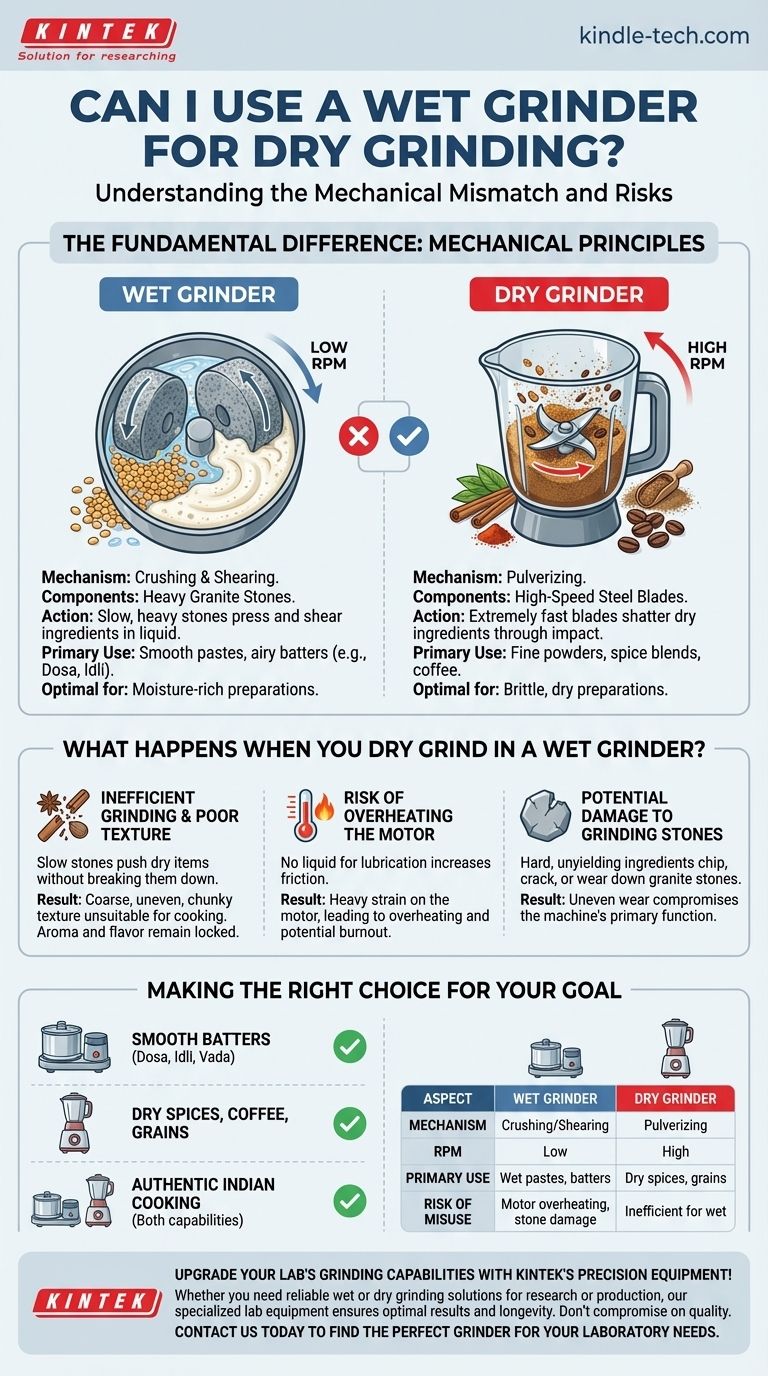While some industrial mills can handle both, a typical home wet grinder should not be used for dry grinding. These appliances are engineered specifically for creating wet pastes and batters. Attempting to grind dry spices or grains will yield poor results and risks damaging the machine's motor and grinding stones.
The core issue is a mismatch in mechanical design. A wet grinder uses slow, heavy stones to crush and shear ingredients within a liquid medium, while a dry grinder uses high-speed blades to pulverize brittle, dry ingredients. Using one for the other's task is ineffective and potentially destructive.

The Fundamental Difference: Wet vs. Dry Grinding
To understand why these tools aren't interchangeable, you must first understand their distinct mechanical principles. They are not simply two versions of the same machine; they are fundamentally different tools designed to solve different physical problems.
The Mechanics of a Wet Grinder: Crushing and Shearing
A home wet grinder operates at a low RPM (Revolutions Per Minute). Its primary components are heavy granite stones.
These stones slowly turn and press against the ingredients, creating a crushing and shearing force. This action is perfect for breaking down soaked grains and lentils, releasing starches, and emulsifying them into a smooth, airy batter without generating excessive heat. The water or liquid acts as a crucial medium for movement and temperature control.
The Mechanics of a Dry Grinder: Pulverizing
A dry grinder—often a specific jar on a mixer-grinder or "mixie"—operates at an extremely high RPM.
It uses small, sharp stainless steel blades that spin at thousands of revolutions per minute. This incredible speed doesn't crush; it shatters and pulverizes hard, dry ingredients like spices, coffee beans, or dry grains through repeated high-velocity impact, turning them into a fine powder.
What Happens When You Dry Grind in a Wet Grinder?
Attempting to use a wet grinder for dry ingredients leads to a series of predictable problems, ranging from disappointing culinary results to permanent appliance damage.
Inefficient Grinding and Poor Texture
The slow-moving stones are not designed to break down hard, dry items effectively. Instead of producing a fine powder, the grinder will likely just push the spices or grains around the drum.
The result is a coarse, uneven, and chunky texture that is unsuitable for most recipes. The unique aroma and flavor of spices, which are released through fine grinding, will remain locked away.
Risk of Overheating the Motor
Wet grinding uses liquid to lubricate the process and dissipate the heat generated by friction. Without this liquid, grinding dry ingredients creates significantly more friction.
This increased load puts a heavy strain on the low-RPM motor, causing it to overheat. Over time, this can lead to permanent motor burnout, rendering the entire appliance useless.
Potential Damage to the Grinding Stones
The granite stones in a wet grinder are designed to work against soft, soaked ingredients. Pitting them against hard, unyielding items like whole peppercorns or hard grains can cause the stones to chip, crack, or wear down unevenly. Damaged stones will no longer produce a smooth batter, compromising the machine's primary function.
Understanding the Trade-offs
The desire to use one appliance for multiple tasks is practical, aimed at saving counter space and money. However, in this case, the trade-offs are not worth the convenience.
The Cost of Poor Results
The texture of your ingredients is fundamental to the final dish. Using coarsely broken spices from a wet grinder will lead to gritty curries and bland-tasting food, negating the effort you put into cooking.
The Cost of a Damaged Appliance
The most significant risk is financial. A quality wet grinder is an investment. Attempting to save money by not buying a small, dedicated dry grinder can easily result in you having to replace your much more expensive wet grinder. A simple coffee or spice grinder is a far cheaper alternative.
Making the Right Choice for Your Goal
Select your appliance based on its intended purpose to achieve the best results and ensure its longevity.
- If your primary focus is making smooth batters for dosa, idli, or vada: A wet grinder is the essential, non-negotiable tool for the job.
- If your primary focus is grinding dry spices, coffee, or small amounts of grain: You must use a dedicated dry grinder, spice grinder, or a mixer-grinder with its dry-grinding jar.
- If you need both capabilities for authentic Indian cooking: The correct approach is to own both a wet grinder for batters and a separate mixer-grinder for dry spices and chutneys.
Using the right tool for the right task ensures perfect results and protects your valuable kitchen equipment.
Summary Table:
| Aspect | Wet Grinder | Dry Grinder |
|---|---|---|
| Mechanism | Slow, heavy stones for crushing/shearing | High-speed blades for pulverizing |
| RPM | Low RPM | High RPM |
| Primary Use | Wet pastes, batters (e.g., dosa, idli) | Dry spices, coffee beans, grains |
| Risks of Misuse | Motor overheating, stone damage, poor texture | Inefficient for wet ingredients |
Upgrade your lab's grinding capabilities with KINTEK's precision equipment! Whether you need reliable wet or dry grinding solutions for research or production, our specialized lab equipment ensures optimal results and longevity. Don't compromise on quality—contact us today to find the perfect grinder for your laboratory needs. KINTEK specializes in lab equipment and consumables, serving laboratory needs with durable, high-performance tools.
Visual Guide

Related Products
- Liquid Nitrogen Cryogenic Grinder Mill Cryomill Airflow Ultrafine Pulverizer
- Mini Planetary Ball Mill Machine for Laboratory Milling
- High Energy Planetary Ball Mill Machine for Laboratory Horizontal Tank Type
- Powerful Plastic Crusher Machine
- Single Punch Tablet Press Machine and Mass Production Rotary Tablet Punching Machine for TDP
People Also Ask
- What is the temperature of cryogenic grinding? Achieve Superior Particle Size & Preserve Heat-Sensitive Materials
- What is the difference between a pulverizer and a ball mill? Choose the Right Grinding Technology
- How can I improve my ball mill performance? Optimize Speed, Media, and Material for Peak Efficiency
- What are cryogenic ground spices? Unlock Maximum Flavor with Advanced Grinding Technology
- What is the process of cold grinding? Achieve Superior Powder Quality for Heat-Sensitive Materials



















